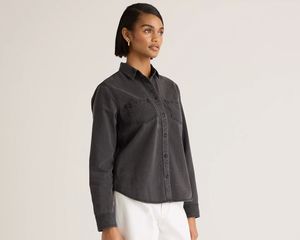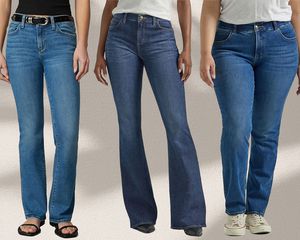We’ve all had one (or two or several). Maybe she was cowl-necked and cropped or made out of faux chainmail or chevron print with a peplum. Perhaps she was a slinky, silky halter or a bejeweled bustier in which you channeled your inner Selena. She was your ultimate ally when you were heading directly from work to the club, your ride-or-die when your bestie insisted you be her wingwoman for the night.
She is the going-out top, and every party girl—or aspiring party girl or part-time party girl or “party when she has to” girl—has donned her at some point. And while her popularity may wax and wane, as we head toward 2023, she’s once again That Girl.
It would be an insult to history to suggest that the party girl is a modern invention—I’m sure there are going-out tops that date back to antiquity—but the rise of pants as an acceptable form of everyday wear for women in the mid-20th century, specifically the 1960s and 1970s, is undoubtedly a crucial moment in the history of the going-out top. These are the same decades that gave us the pill, wider access to contraception, Second-Wave Feminism, and American fashion generally becoming more casual. And this “casualization” of fashion directly led to what might just be the most significant predecessor to the going-out top: the rise of designer denim.
:max_bytes(200000):strip_icc()/embed41-572ef060937c4117859f138138e411c3.jpg)
Getty Images / Design by Tiana Crispino
In the 1980s, Brooke Shields became inseparable from her Calvins, Gloria Vanderbilt parlayed her patrician pedigree into a mega-successful denim line, and blue jeans solidified their status as one of the most ubiquitous articles of clothing in American life. And they retain that status to this day. “Blue jeans have become international,” American History Museum Curator Emeritus Nancy Davis told Smithsonian Magazine. “It’s what people think of. When they think of America, they think of blue jeans.”
I would argue this ubiquity played no small part in the rise of the going-out top. The most iconic going-out tops—which, in my humble opinion, generally emerge in the early 21st century—are most frequently paired with denim; usually jeans, sometimes a skirt, and almost always low-rise. Think Destiny’s Child feting Janet Jackson in lingerie-inspired tops paired with pelvis-skimming blue jeans and bejeweled, pointy-toed pumps. Or Christina Aguilera at the 2001 VMAs in patchwork denim pants and a silky cropped cami.
Before we go any further, it might be useful to outline what, exactly, the going-out top is. I took to my Instagram stories to ask my friends and associates what and who they think of when they think of the going-out top. And while the answers were all thought-provoking—ranging from “those ‘invisible’ plastic bra straps” to anything worn by a Real Housewife of Orange County, season 1—one stood out, in particular, in terms of defining the going-out top: “Something that flatters the titties.” (Shoutout to my friend, RM, for that.)
:max_bytes(200000):strip_icc()/Zendaya21-3874e45ad64141e1bea0be0ddcbcf2ab.jpg)
Getty Images / Design by Tiana Crispino
Of course, not everyone who wears a going-out top has breasts, and not everyone with breasts is looking to flatter them. But this definition speaks to how the going-out top is supposed to make you feel: a little special. If you’re wearing blue jeans during the day and on a regular or semi-regular basis—to school or work and for both comfort and style—it makes sense that, in the evening, you would seek to pair them with an article of clothing that really draws a firm line in the sand between your activities. An article of clothing that says, “I’m effortless enough to be wearing my favorite worn-in blues but still kinda want to feel like I put in some work before convincing myself to come out tonight.”
Indeed, in a world emerging from lockdown, “effortless” is the name of the game. Much has been written about the ways in which the pandemic saw a boom in athleisure, and after two years working in sweatpants and leggings, people are both uneager to get back into stuffy, structured garments and longing to feel a bit gussied up. And the going-out top is the perfect marriage of those two sentiments: Your top is at the party, but your bottoms are metaphorically at home on the couch.
And as it happens, our current sartorial landscape is also heavily influenced by the early 2000s. I’ve written before about the Gen-Z infatuation with Y2K style, which has only grown stronger over the last year. Driven by the combination of nostalgia and social media—the latter providing a wealth of going-out top references to pull from—the GOTs of today often look similar to those of the aughts. “When I hear ‘going-out top’, I think of something that is a little bit sexy, dressy, and fun that can easily be layered,” says Sky Pollard, head of product for Nuuly. “Right now, there are a lot of trends that dovetail nicely with this like sheer black bodysuits, corsets, and sparkle.” She cites the rental service’s hit pieces such as Afrm’s Astra Sheer Top, Urban Outfitter’s Milina Satin Fringe Top (very prime Paris Hilton), or Favorite Daughter’s The Floral Corset Top (which is giving me major “Bella Swan goes to homecoming energy”). “Pair any of these with black jeans or trousers and a blazer for an easy date-night look.” she adds.
We want easy and want fun, but we want to make it fashion—which is exactly what the going-out top provides. Long may she reign.
:max_bytes(150000):strip_icc()/2022Q4DI_KH_LandinPage-RECIRC-f77a3f3d341c4f6eb88170b77cac5d6c.jpg)
:max_bytes(150000):strip_icc()/BYR_InterviewRecirc2-a0391f176ace43249a5d41f2dea1d1a5.jpg)
:max_bytes(150000):strip_icc()/B-Side-RECIRC-12bf1dd671ec4a30b94e18592eebe4df.jpg)
:max_bytes(150000):strip_icc()/RECIRC_HolidayNails1-46a0aac32a0d425b829eb689ba41af91.jpg)
:max_bytes(150000):strip_icc()/Recirc16-d6f668526db14392a101969ba9acc9d0.jpg)
:max_bytes(150000):strip_icc()/RECIRC_PartyGirl-e4b9a3958e1742359601e60a3c67cc45.jpg)
:max_bytes(150000):strip_icc()/Recirc-4d350ecc988045f3b460233b8334ca19.jpg)
:max_bytes(200000):strip_icc()/SF_GoingOUt1-a0667d68786f4b138aa73b722aa12b7f.jpg)

